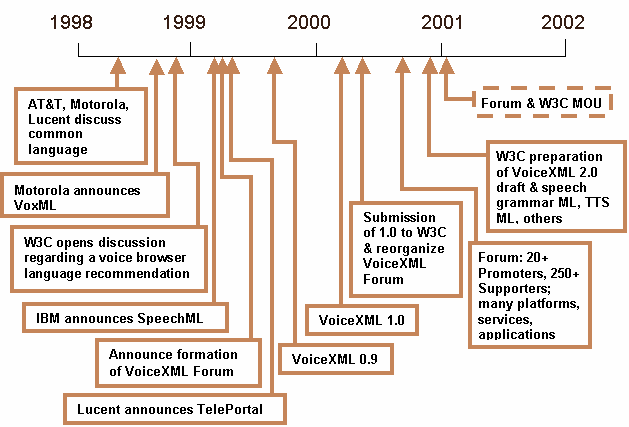| |
Open
Dialog: Activities of the VoiceXML Forum and W3C
With
the launch of the VoiceXML
Forum in March of 1999, and the release of the VoiceXML
1.0 specification in March 2000, there has been
a surge of activity in the speech and telephony industry
around the VoiceXML concept, products and services.
In conjunction with these events, the VoiceXML community
has been progressing the language further and improving
the business environment in which VoiceXML exists. Most
notableare the efforts of the VoiceXML Forum and the
World Wide
Web Consortium (W3C) Voice
Browser Working Group (VBWG).
Figure 1 below provides a brief history lesson in how
all the participants work together.

Figure
1: Timeline of Speech and Telephony Activities
The VoiceXML Forum's process to develop a language was
initiated by AT&T,
Lucent,
and Motorola
in mid-1998. The result of this collaboration was a
contribution to a W3C-sponsored workshop on Voice Browsers
in November 1998. As a result of this meeting and discussions
among the three companies, a decision was made to create
the VoiceXML Forum to accelerate the definition of a
common markup language for telephony and speech applications
and hopefully bootstrap the industry. Three key events--the
announcement of the Forum in March 1999, the addition
of IBM
as one of the founders, and the creation of a draft
specification, VoiceXML 0.9 in August 1999--generated
important momentum in the speech and telephony industry.
In this same time frame, in late March 1999, the W3C
formed the Voice Browser Working Group (VBWG) to explore
the full range of markup languages, including speech
grammars, speech synthesis, natural language, and, of
course, speech dialogs--the core of VoiceXML. The W3C
created requirements for these interrelated languages,
and began work on defining them, in many cases leveraging
upon work that had been undertaken by other organizations
or companies. The W3C VBWG monitored the VoiceXML Forum
activities, to see if the VoiceXML effort could be harnessed
for the W3C speech dialog work.
The VoiceXML Forum accepted public and membership comment
on the VoiceXML 0.9 specification, and worked through
late 1999 and early 2000 to produce the final release:
VoiceXML 1.0 on 7 March 2000. The full release from
the Forum again sparked momentum in the marketplace.
After releasing the specification, the VoiceXML Forum
decided to begin the process of submitting it to the
W3C for the dialog language effort in the VBWG. This
step was officially completed in May 2000, when the
W3C acknowledged the submission and the VBWG adopted
it as the basis for its dialog markup language.
In
May 2000, the VoiceXML Forum decided to reorganize in
several ways:
-
To expand the range of Forum activities (language
definition had been the chief task until that time)
- To
open up greater opportunities for participation of
Forum members
- Concentrate
on nurturing the industry and raising awareness while
the language work had time to become adopted,
- Engage
the IEEE
Industry Standards and Technology Organization
(ISTO) to provide day-to-day management of the Forum.
Thus by September 2000, VoiceXML Forum launched a new
membership structure and began new committees for Marketing,
Conformance and Education. The new membership structure
introduced three membership levels:
-
Sponsor: Held by the Forum's four founding
companies, and providing the primary operational funding
for the Forum;
-
Promoter: A paid annual membership level;
- Supporter:
A free membership level.
Status
as Promoters or Sponsors enabled member companies to
participate in or chair committee work. This provided
for a much greater opportunity for involvement and more
volunteer resources upon which to draw. For example,
VoiceXML Review is a tangible output of this
restructuring.
Continued...

back
to the top

Copyright
© 2001 VoiceXML Forum. All rights reserved.
The VoiceXML Forum is a program of the
IEEE
Industry Standards and Technology Organization
(IEEE-ISTO).
|

